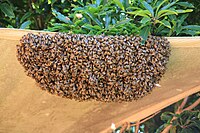
Photo from wikipedia
Identification of honey origin based on specific chemical markers is important for honey authentication. This study is aimed to differentiate Malaysian stingless bee honey from different entomological origins (Heterotrigona bakeri,… Click to show full abstract
Identification of honey origin based on specific chemical markers is important for honey authentication. This study is aimed to differentiate Malaysian stingless bee honey from different entomological origins (Heterotrigona bakeri, Geniotrigona thoracica and Tetrigona binghami) based on physicochemical properties (pH, moisture content, ash, total soluble solid and electrical conductivity) and volatile compound profiles. The discrimination pattern of 75 honey samples was observed using Principal Component Analysis (PCA), Hierarchical Clustering Analysis (HCA), Partial Least Square-Discriminant Analysis (PLS-DA), and Support Vector Machine (SVM). The profiles of H. bakeri and G. thoracica honey were close to each other, but clearly separated from T. binghami honey, consistent with their phylogenetic relationship. T. binghami honey is marked by significantly higher electrical conductivity, moisture and ash content, and high abundance of 2,6,6-trimethyl-1-cyclohexene-1-carboxaldehyde, 2,6,6-trimethyl-1-cyclohexene-1-acetaldehyde and ethyl 2-(5-methyl-5-vinyltetrahydrofuran-2-yl)propan-2-yl carbonate. Copaene was proposed as chemical marker for G. thoracica honey. The potential of different parameters that aid in honey authentication was highlighted.
Journal Title: Food chemistry
Year Published: 2020
Link to full text (if available)
Share on Social Media: Sign Up to like & get
recommendations!